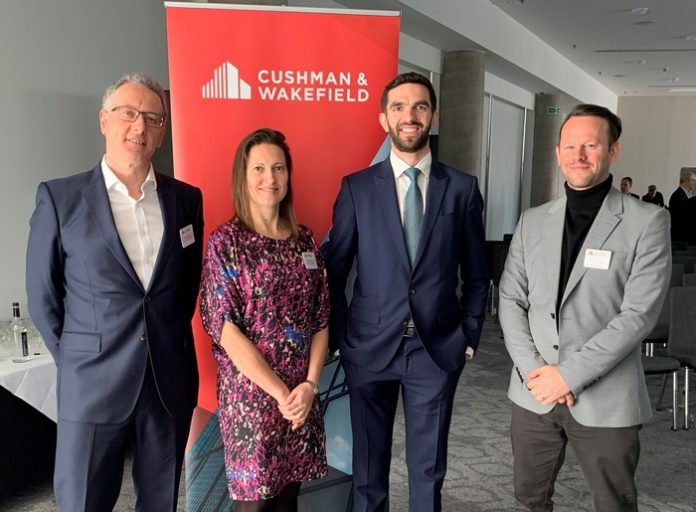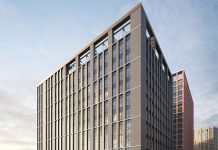
The North West Logistics market looks set to remain one of the top performers of the region’s property market, with the Build To Rent sector and other alternatives set to attract a growing amount of institutional investment capital over the coming years, according to Cushman & Wakefield.
The findings were presented at Cushman & Wakefield’s annual Property Outlook event for the Commercial Property Market for 2019 and beyond held at The Lowry Hotel in Manchester.
Bruce Poizer, Partner and Head of Capital Markets at Cushman & Wakefield in Manchester said: “Industrial take-up reached 5.7 million sq ft in 2018 which was 20% ahead of the five-year average, driven largely by the letting of second-hand space. We also saw a wave of speculative development in the region last year with over 4.5 million sq ft either completed or under construction.
“Whilst e-commerce is driving growth nationally, manufacturing is still key for this sector in the North West, accounting for 30% of take-up last year. Take-up is down in the first quarter, but we expect momentum will pick up in the second half of the year and anticipate a bounce in manufacturing take-up once the Brexit impasse has been clarified.”
In the Offices market, Bruce discussed the evolution of flexible work space which has been the big story with take-up in Manchester accounting for an average of 110,000 sq ft in the last three years.
He said: “Aside from WeWork, there are many providers now established in Manchester these include Central Working which has taken 18,000 sq ft in 55 Spring Gardens and Huckletree with 26,000 sq ft in Express Buildings. These sit amongst existing landlords such as Burntwood’s ‘Made and Managed’ product.”
“In the Retail market, despite doom and gloom in the headlines, good retail and leisure destinations will continue to thrive but there will be a growing number of failed or over-spaced retail schemes which will provide opportunities for re-purposing and redevelopment. The outlook for Manchester city centre is strong however with the city exceeding regional and national growth averages.”
Bruce said: “The Residential market in Manchester continues to thrive with many foreign investors targeting the city. Over the last five years Manchester residential values have increased by 45% in comparison to the rest of the UK at 30%. We anticipate this trend will continue with average price growth of over 3.6% over the next 5 years.
“Increasing demand for rental properties in Manchester city centre from a wide demographic has seen the expansion of the Build To Rent (BTR) sector and we predict this market will continue to mature. We will see developers overcome development viability issues to commit to new schemes outside the region’s main cities and will also see the emergence of a two-storey Family Housing rental model.”
“Most of the institutions are either actively pursuing BTR or are putting plans in place so we can expect a lot more investment capital targeting the sector in the coming years.”
There were also presentations from Greg Mansell, Head of UK Research & Insight who discussed ‘Opportunities Amidst Uncertainty’. He highlighted that despite concerns over Brexit and Global trade, UK business has ‘held its nerve’.
Greg Mansell said: “The impact of Brexit on UK financial services and real estate has been over-stated with fewer firms relocating staff into EU countries than had been forecast. The threat of trade wars and protectionism is likely to have a far greater impact on the real estate sector, although Brexit may cause short-term disruption.”
He continued: “As Brexit and other sources of uncertainty dominate the headlines, we can get fixated on the ‘here and now’ but real estate is a long-term game.
“Over the coming years, there are many non-cyclical trends that will create opportunities for investors and occupiers who stay ahead of the curve. These trends will be in place regardless of global trade volumes, Brexit or any other external force.”
These opportunities include the next generation of tenants, the rise of Coworking and Alternative real estate, such as healthcare and student living, which accounted for an all-time high of 32% of regional investment volumes in 2018.
Greg concluded: “Markets that have strong fundamentals will stay popular with core investors. Meanwhile, the more challenged parts of the market will see pricing drift until they look good value for opportunistic investors looking to redevelop and repurpose assets. There is plenty of capital looking for these opportunities.”
Richard Pickering, Cushman & Wakefield’s Head of Futures Strategy concluded by discussing the impact digitisation will have on real estate over a longer horizon. He considered the potential for activities currently carried out using real estate to be substituted by digital alternatives, and posed the question, ‘Could this mean the end of real estate?’
“In short, no,” said Richard “however, we in the industry need to treat this as a wake-up call. The same trends we see today in retail, have the potential to bleed into other sectors. Digital business models tend to have cost and convenience advantages. This sets a challenge for real estate investors to reposition their assets and portfolios to focus on real estate’s inherent strengths, such as end-user engagement and experience. For the best innovations in this space we need to look increasingly outside of our industry, and be willing to challenge long held paradigms of the role of real estate.”





















